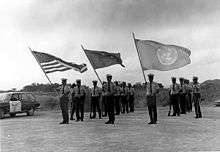United Nations Trust Territories
United Nations trust territories were the successors of the remaining League of Nations mandates, and came into being when the League of Nations ceased to exist in 1946. All of the trust territories were administered through the United Nations Trusteeship Council. The one territory not turned over was South-West Africa, which South Africa insisted remained under the League of Nations Mandate. It eventually gained independence in 1990 as Namibia. The main objection was that the trust territory guidelines required that the lands be prepared for independence and majority rule.
The concept is distinct from a territory temporarily and directly governed by the United Nations.
Trust territories (and administering powers)
Former German Schutzgebiete
All these territories previously were League of Nations mandates.
- The Trust Territory of the Cameroons under French administration (French Cameroons): Achieved independence as the Republic of Cameroon in 1960.
- The Trust Territory of the Cameroons under British administration (British Cameroons): Somewhat smaller than the French Cameroons, this territory was administered in two parts (Northern Cameroons and Southern Cameroons). Following a plebiscite, Northern Cameroons became part of Nigeria in May 1961 and Southern Cameroons joined the Republic of Cameroon in October 1961.
- The Territory of New Guinea (Australia): The north-eastern section of this island had been a League of Nations mandate, the south-eastern section had been Australian before World War I; after World War II, the two were combined into a unified entity for administrative purposes, although the legal distinction between the Territory of Papua and the Territory of New Guinea was maintained. In 1975, the two entities were legally unified and granted independence as Papua New Guinea. The western half of the island, formerly Dutch and now part of Indonesia, was never part of either territory.
- The Trust Territory of Ruanda-Urundi (Belgium, effectively linked to the Belgian Congo): Separately gained independence in 1962 as Rwanda and Burundi.
- The Trust Territory of Tanganyika (United Kingdom): Granted independence in 1961. Federated with the former British protectorate Zanzibar in 1964 to form Tanzania.
- The Trust Territory of Togoland under French administration (French Togoland): Became independent as Togo in 1960.
- The Trust Territory of Togoland under British administration (British Togoland): Much smaller than French Togoland, this territory was merged in 1956 with the British colony of the Gold Coast, which was granted independence as Ghana in 1957.
- The Trust Territory of Western Samoa (New Zealand): Granted independence in 1962, now known simply as Samoa.
Former German and/or Japanese colonies


These territories were also former League of Nations mandates.
- The Trust Territory of Nauru (Australia (in effective administrative control), New Zealand and United Kingdom): Granted independence in 1968.
- The Trust Territory of the Pacific Islands (United States): Split into the Republic of the Marshall Islands (1979), the Federated States of Micronesia (1979), the Commonwealth of the Northern Mariana Islands (1978) and the Republic of Palau (1981). With the exception of the Northern Mariana Islands, which is an American commonwealth, these are all associated states of the United States.
Former Italian possessions
- The Trust Territory of Somaliland under Italian administration: Italy was appointed U.N. trustee of the former Italian Somaliland in 1950. In 1960, the Trust Territory merged with the former British Somaliland protectorate to form the Somali Republic (Somalia).
Proposed trust territories
- Korea: In wartime talks, Franklin D. Roosevelt proposed that Korea be placed under an American–Soviet trust administration. The plan was eclipsed after Roosevelt's death on 12 April 1945, although it was expressed in the December Moscow Conference, and caused considerable civil unrest in Korea.[1]
- Mandatory Palestine: United States government under Harry Truman proposed a UN trusteeship status for the Mandatory Palestine in 1948.[2]
References
- ↑ Gang Man-gil (1994). "한국사 17: 분단구조의 정착 1" ["17 Korean history: the settlement of the division structure 1"], pp. 133–137. 한길사 [Hangilsa], ISBN 978-89-356-0086-1
- ↑ "The United States and the Recognition of Israel: A Chronology". Compiled by Raymond H. Geselbracht from Harry S. Truman and the Founding of Israel (Westport, Connecticut, 1997) by Michael T. Benson. Harry S. Truman Library and Museum. Retrieved 3 August 2014.
Bibliography
- The United Nations and Decolonization: Trust Territories that Have Achieved Self-Determination
- WorldStatesmen- links to each present nation
External links
![]() Media related to United Nations Trust Territories at Wikimedia Commons
Media related to United Nations Trust Territories at Wikimedia Commons
|